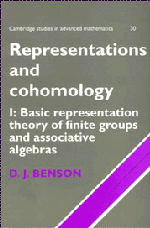Book contents
Chapter 3 - Modules for group algebras
Published online by Cambridge University Press: 26 January 2010
Summary
In Chapter 1 we gave a brief summary of some standard material on rings and modules. In this chapter we investigate what more we can say if the ring is the group algebra RG of a finite group G over a ring of coefficients R. The major new feature we find here is that we may give the tensor product over R of two RG-modules the structure of an RG-module. Of course, we also try to relate the subgroup structure of the group with the representation theory.
Throughout this chapter, R will denote a commutative ring of coefficients, and κ will denote a field of coefficients. All RG-modules and κG-modules will be finitely generated.
Operations on RG-modules
Definition 3.1.1. If G is a finite group and R is a commutative ring, we may form the group ringRG whose elements are the formal linear combinations with ri ∈ R and gi ∈ G. Addition and multiplication are given by
Thus RG is an R-algebra, which as an R-module is free of rank |G|.
Of course, this definition also makes sense for infinite groups, provided we restrict our attention to finite sums.
The group ring RG is an augmented algebra with augmentation ε : RG → R given by
(cf. Section 2.4). Thus it makes sense to talk of the trivialRG-module R. We write Hn(G, M) and Hn(G, M) for the homology and cohomology groups with coefficients in M, namely the groups Hn(RG, M) and Hn(RG, M) defined in Section 2.6. Note that in the former case we should regard the left RG-module M as a right module via mg = g−1m.
- Type
- Chapter
- Information
- Representations and Cohomology , pp. 49 - 98Publisher: Cambridge University PressPrint publication year: 1991

